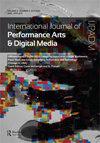Across the Nebraska Border and the virtual-material divide: contextualizing Shu Lea Cheang’s Brandon, 1994–1999
IF 0.9
0 THEATER
International Journal of Performance Arts and Digital Media
Pub Date : 2021-05-04
DOI:10.1080/14794713.2021.1934636
引用次数: 2
Abstract
ABSTRACT This paper situates Shu Lea Cheang's Brandon within its conditions of production, drawing from documents that place Cheang in dialogue with several key artists and critical thinkers who offered incisive early critiques of popular ideas and common anxieties about how embodied subjectivity, and the social formations through which it is assigned meaning, may or may not be transformed in the digital future. Through a close reading of the website and corollary programs, I suggest that the work itself reflects a crucial engagement with these theories – conceptually and technologically – in cyberspace. Indeed, contextualizing the production of Brandon reveals the various ways in which Cheang drew from the theories of her collaborators (among others) to test how they would function not as analyses of cyberspace but performances in cyberspace. Brandon, among many other things, is thus a space of praxis, in which the possibilities and limitations of early critical theories of digital embodiment and subjectivity were examined.跨越内布拉斯加边界和虚拟物质鸿沟:以舒的《布兰登》为背景,1994-1999
摘要:本文将舒的《布兰登》置于其生产条件下,从一些文件中汲取灵感,这些文件将舒与几位关键艺术家和批判性思想家进行了对话,他们对流行思想和普遍焦虑提出了尖锐的早期批评,即主体性是如何体现的,在数字未来可能被转换,也可能不被转换。通过仔细阅读网站和相应的程序,我认为这项工作本身反映了在网络空间中对这些理论的重要参与——从概念上和技术上。事实上,将《布兰登》的制作背景化,揭示了谢从合作者(以及其他人)的理论中汲取的各种方式,以测试这些理论如何不是作为网络空间的分析,而是作为网络空间中的表演。因此,在许多其他事物中,布兰登是一个实践空间,在这个空间中,研究了早期数字体现和主观性批判理论的可能性和局限性。
本文章由计算机程序翻译,如有差异,请以英文原文为准。
求助全文
约1分钟内获得全文
求助全文
来源期刊

International Journal of Performance Arts and Digital Media
Arts and Humanities-Visual Arts and Performing Arts
CiteScore
1.70
自引率
0.00%
发文量
29
 求助内容:
求助内容: 应助结果提醒方式:
应助结果提醒方式:


